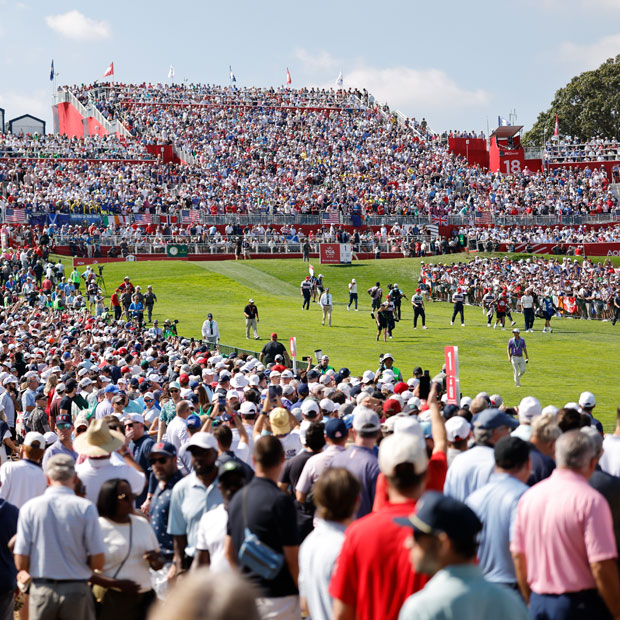Valhalla’s Open-Book Test on Display at the PGA Championship
What makes Valhalla susceptible to scoring like this, soft or not?


It’s been a rough week for Valhalla Golf Club—or, as the hats say, “Halla.” For one thing, the logistics of getting into and out of the facility have been a nightmare. For another, players have feasted on the rain-softened course; numbers in the mid to low 60s have been a common sight on the leaderboard. Yes, major championships should visit all parts of our great country, and the city of Louisville is certainly a worthy host. I’m just not sure this version of Valhalla is up to snuff.
This isn’t just a reaction to the scoring, which is predictably low given the soft conditions. Mainly I’m disappointed in the lack of variety in the golf shots players need to hit, the repetition of narrow fairway after narrow fairway and boring green after boring green. Valhalla is missing creative, distinctive architecture. Several holes appear to have no strategy except for “hit it straight.”
Jack Nicklaus designed Valhalla in 1986 to be a brute of a tournament golf course. It spans a massive property and features big holes with narrow fairways—the quintessential “championship test” of the era in which it was built. This type of course used to torment the best players in the world. During the 1980s and up until the early 2000s, hitting the ball far, high, and fairly straight was the greatest secret and challenge of the game. Back then, the prevailing knowledge of the golf swing and the quality of the equipment were such that very few players could strike the ball well enough to conquer a course like Valhalla.
But that changed with the advent of solid-core golf balls, 460cc drivers, and launch-monitor technology. Today, hitting the ball far, high, and fairly straight is a more achievable and common skill. As a result, courses that focus narrowly on testing this skill have become obsolete.
Such is the predicament of many once-feared championship venues. Valhalla is one of these. It’s a course that asks a question that professional golfers solved a decade ago. So the organizations that run elite tournaments must move on from the notion that championship golf means long courses with narrow fairways and thick rough.
There’s no easy answer for what a major venue should look like today, but I think you have to start with green design. I doubt that any course can test today’s Trackman stars in a compelling way without unconventional, boldly contoured greens. Not surprisingly, almost all of Valhalla’s greens are pretty conventional and straightforward. On this kind of course, the best current golfers employ a simple strategy on approach shots: aim to the fat side of the pin, and at worst you’ll walk away with a par. So if you want to challenge these players, you have to threaten them with some kind of downside if they play away from the flag. They have to worry about the possibility of a three-putt. Otherwise they’ll simply play safe and allow themselves to run into some birdies.
A course that does a good job striking fear into the hearts of unaggressive golfers is Augusta National. The greens make that golf course. They force players to take on tucked pins because the bail-out zones on the putting surfaces are so unappealing. We see contenders at the Masters playing assertively from Thursday to Sunday because you don’t have a chance to win if you spend the whole tournament sizing up 30-foot putts that break eight feet.
Think about the courses that currently present the best (admittedly a subjective term) test for top players: Augusta National, Shinnecock Hills, Oakmont, Pinehurst No. 2, etc. What they have in common is a terrifying set of greens. This is what scares players today, not narrow fairways and thick rough. The fear of a three-putt is the only thing that can persuade the modern pro not to play away from the flag.
Consider the 13th hole at Valhalla on Friday. The PGA of America tucked the pin way left, and all day long we watched the world’s best play away from it, content with a 20-foot, relatively flat putt for birdie. They all knew that attacking that hole location was a fool’s errand, and they all were confident that they could at least two-putt from the safe side. The only way to get them to even think about going at that flag would be to re-contour the green and make that 20-footer more difficult.
Thankfully, a good golf course is not the sole ingredient for a memorable championship. When you put a bunch of great players in front of enthusiastic crowds in Louisville, you’ll usually have a fun weekend. It certainly seems like we’re headed that direction this Sunday. But it should concern us all that the number of courses capable of both challenging today’s pros and accommodating the infrastructure of a 21st-century major is dwindling severely. In order to address this issue, we need to rethink what championship golf looks like.
Related Articles:
– Design Notebook: Pre-Empting the Valhalla Eulogies
– Three Valhalla Talking Points
This piece originally appeared in the Fried Egg Golf newsletter. Subscribe for free and receive golf news and insight every Monday, Wednesday, and Friday. For more coverage of the PGA Championship, visit our PGA hub here.
Leave a comment or start a discussion
Engage in our content with thousands of other Fried Egg Golf Club Members
Engage in our content with thousands of other Fried Egg Golf Members
Get full access to exclusive benefits from Fried Egg Golf
- Member-only content
- Community discussions forums
- Member-only experiences and early access to events











Leave a comment or start a discussion
Lorem ipsum dolor sit amet, consectetur adipiscing elit. Suspendisse varius enim in eros elementum tristique. Duis cursus, mi quis viverra ornare, eros dolor interdum nulla, ut commodo diam libero vitae erat. Aenean faucibus nibh et justo cursus id rutrum lorem imperdiet. Nunc ut sem vitae risus tristique posuere. uis cursus, mi quis viverra ornare, eros dolor interdum nulla, ut commodo diam libero vitae erat. Aenean faucibus nibh et justo cursus id rutrum lorem imperdiet. Nunc ut sem vitae risus tristique posuere.